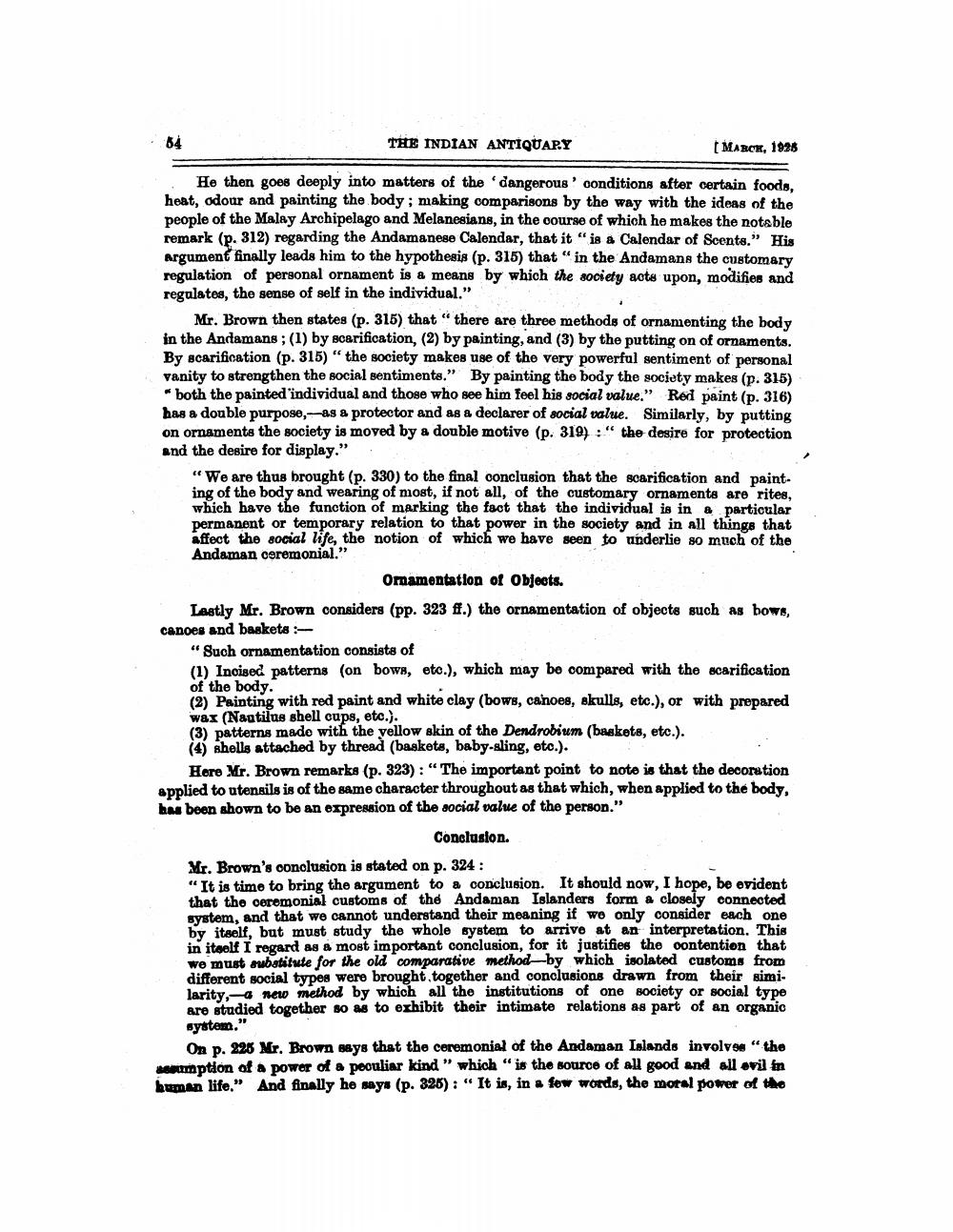________________
• 84
THE INDIAN ANTIQUAP.Y
(MABOK, 1928
He then goes deeply into matters of the dangerous' conditions after certain foods, heat, odour and painting the body; making comparisons by the way with the ideas of the people of the Malay Archipelago and Melanesians, in the course of which he makes the notable remark (p. 312) regarding the Andamanese Calendar, that it is a Calendar of Scents." His Argument finally leads him to the hypothesis (p. 315) that " in the Andamans the customary regulation of personal ornament is a means by which the society acts upon, modifies and regulates, the sense of self in the individual."
Mr. Brown then states (p. 315) that "there are three methods of ornamenting the body in the Andamans; (1) by scarification, (2) by painting, and (3) by the putting on of ornaments. By scarification (p. 315) " the society makes use of the very powerful sentiment of personal vanity to strengthen the social sentiments." By painting the body the society makes (p. 315) * both the painted individual and those who see him feel his social value." Rod paint (p. 316) has a double purpose,--as a protector and as a declarer of social value. Similarly, by putting on ornaments the society is moved by a double motive (p. 319) :" the desire for protection and the desire for display." .
“We are thus brought (p. 330) to the final conclusion that the scarification and painting of the body and wearing of most, if not all, of the customary ornaments are rites, which have the function of marking the fact that the individual is in a particular permanent or temporary relation to that power in the society and in all things that affect the social life, the notion of which we have seen to underlie so much of the Andaman ceremonial.”
Omamentation of objects.
Lastly Mr. Brown considers (pp. 323 f.) the ornamentation of objects such as bows, canoes and baskets
"Such ornamentation consists of (1) Incised patterns (on bows, etc.), which may be compared with the scarification of the body. (2) Painting with red paint and white clay (bows, canoes, skulls, etc.), or with prepared wax (Nautilus shell cups, etc.). (3) patterns made with the yellow skin of the Dendrobium (baskets, etc.). (4) shells attached by thread (baskets, baby-sling, eto.).
Hore Mr. Brown remarks (p. 323): "The important point to note is that the decoration applied to utensils is of the same character throughout as that which, when applied to the body, has been shown to be an expression of the social value of the person."
Conclusion. Mr. Brown's oonclusion is stated on p. 324 : "It is time to bring the argument to a conclusion. It should now, I hope, be evident that the ceremonial customs of the Andaman Islanders form a closely connected system, and that we cannot understand their meaning if we only consider each one by itself, but must study the whole system to arrive at an interpretation. This in itself I regard as a most important conclusion, for it justifies the oontention that we must substitute for the old comparative method-by which isolated customs from different social types were brought together and conclusions drawn from their similarity, new method by which all the institutions of one society or social type are studied together so as to exhibit their intimate relations as part of an organic system."
On p. 228 Mr. Brown says that the ceremonial of the Andaman Islands involves" the somption of a power of a peouliar kind " which " is the source of all good and all evil in human life." And finally he says (p. 326): "It is, in a few words, the moral power of the




